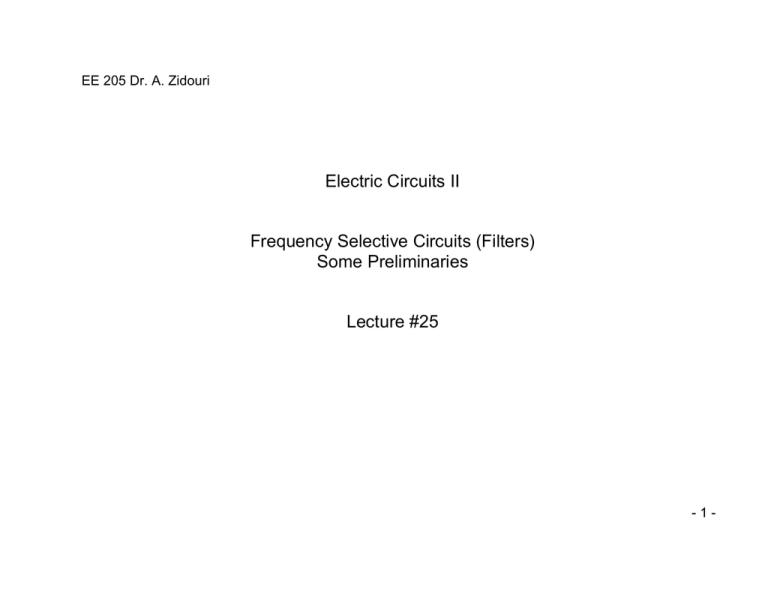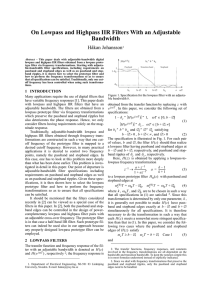Electric Circuits II Frequency Selective Circuits (Filters) Some
advertisement

EE 205 Dr. A. Zidouri Electric Circuits II Frequency Selective Circuits (Filters) Some Preliminaries Lecture #25 -1- EE 205 Dr. A. Zidouri The material to be covered in this lecture is as follows: o o o o Introduction to Filters The Main Four Types of Filter Circuits The Filter Transfer Function Magnitude Plot and Phase Angle Plot After finishing this lecture you should be able to: ¾ Understand the Behavior of Filters ¾ Determine the -2- EE 205 Dr. A. Zidouri Introduction to Filters: Filters Attenuate (Weaken) The Effect Of Any Input Signals With Frequencies Outside A Particular Frequency Band (Range) We Will Restrict Our Study Here To Sinusoidal Signals Only (Voltages) Identifying The Type Of Filter Is To Examine Its Frequency Response Plot There Are Four Major Categories Of Filters Shown In Fig. 7-2 a. The Low-Pass Filter b. The High-Pass Filter c. The Band-Pass Filter d. The Band-Stop Or Band-Reject Filter -3- EE 205 Dr. A. Zidouri Filter Types: -4- EE 205 Dr. A. Zidouri Frequency Response The Frequency Response Plot Has Two Parts ¾ Magnitude Plot ¾ Phase Angle Plot The Cutoff Frequency Separates the Passband from the Stopband The Signals Which are Passed from the Input to the Output Fall Within a Band of Frequencies Called the Passband Frequencies Not in a Circuit’s Passband are in its Stopband Practical Filter Responses cannot Change its Characteristics from Passband to Stopband or vice versa in Zero Frequency. There should be some Transition Bands as well. Filter Specifications The Transmission of a Low-pass Filter as shown in Fig. 7-3 is Specified by four Parameters: ¾ The Passband edge, ωp. ¾ The maximum allowed variation in Passband Transmission, Amax ¾ The Stopband edge, ωs. ¾ The minimum required Stopband Attenuation, Amin -5- EE 205 Dr. A. Zidouri Filter Specifications (cont) |T| dB 0 Amax Amin 0 p s l1 l2 Fig.7-3 Specification of the transmission characteristics of a low-pass filter. The magnitude response of a filter that just meets specifications is also shown. Selectivity factor = ωp / ωs Tighter specification means closer to ideal characteristics and more complex and expensive filter design -6- EE 205 Dr. A. Zidouri Filter Specifications (cont) |T| dB 0 Amax Amin s1 0 l1 v s2 p1 p2 l2 Fig.7-4 Transmission specification of a band-pass filter. The magnitude response of a filter that just meets specifications is also shown. The transmission of a band-pass filter as shown in Fig. 7-4 is specified by six parameters: ¾ The Lower Passband edge, ωp1. ¾ The Higher Passband edge, ωp2. ¾ The maximum allowed variation in Passband Transmission, Amax. ¾ The Lower Stopband edge, ωs1. ¾ The Higher Stopband edge, ωs2. ¾ The minimum required Stopband Attenuation, Amin. -7- EE 205 Dr. A. Zidouri Example 7.1 Consider the following circuit of Fig. 7-5: Z eq 1 ZZ j ωC = R = 1 2 = Z1 + Z 2 R + 1 1+ j ω RC j ωC In polar form Z eq ∠θ = Since Z R R 1+ (ωRC ) 2 ∠− tan −1 ωRC is complex the notation Z(jω) is often used. Both Z and (7-1) (7-2) θ are function of ω. -8- 0 R 5/RC 4/RC 3/RC 2/RC θ |Z| 1/RC EE 205 Dr. A. Zidouri c R/√2 -45o 0 c 1/RC -90o 2/RC 3/RC 4/RC 5/RC Fig. 7-6a Amplitude Response for Circuit in Fig. 7-5 Fig. 7-6b Phase Response for Circuit in Fig. 7-5 -9-




